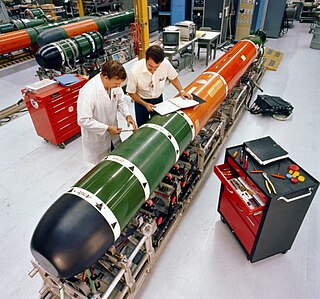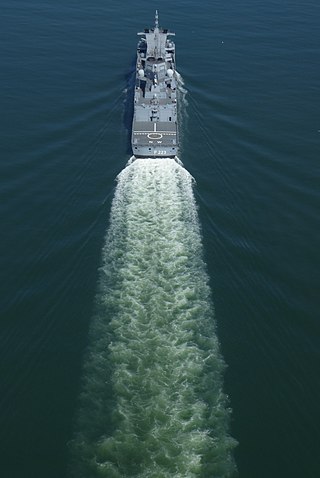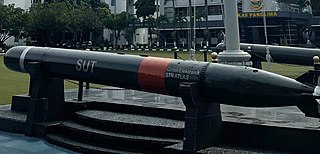Operators
The SeaHake Mod 4 torpedo is in service with eighteen countries and over 300 torpedoes (as of 2015) [12] have been delivered:
| DM2A4 | |
|---|---|
| Type | Torpedo |
| Place of origin | Germany |
| Service history | |
| In service | 2004 |
| Used by | Germany, Greece, Argentina, Chile, Colombia, Ecuador, India, Indonesia, Israel, Norway, Pakistan, Peru, South Africa, South Korea, Spain, Turkey, United Arab Emirates, Venezuela |
| Production history | |
| Designer | Atlas Elektronik |
| Specifications | |
| Mass | 1530 kg [1] |
| Length | 6.6 m (22 ft) |
| Diameter | 533mm |
| Muzzle velocity | 123 metres per second (400 ft/s) |
| Maximum firing range | 50 kilometres (27 nmi) |
| Warhead | PBX |
| Warhead weight | 260 kg |
Detonation mechanism | Proximity or contact detonation |
| Blast yield | 460 kg |
| Engine | Electric; silver-zinc oxide batteries or lithium ion batteries (for exercise) [1] |
| Maximum speed | 50 knots (93 km/h) |
Guidance system | Wire-guided to autonomous (active and passive sonar, wake homing) [1] |
Launch platform | submarine |
DM2A4 Seehecht (export designation "SeaHake mod 4" [2] ) is the latest heavyweight torpedo developed by Atlas Elektronik for the German Navy, as a further update of DM2 (Deutsches Modell 2) torpedo which was released in 1976.
Being the successor of the DM2A3, it features an advanced electrical propulsion system and a fiber-optic cable for torpedo guidance and communication, which, in conjunction with advanced signals processing and mission logic, makes the torpedo largely countermeasure resistant. [3] The DM2A4/SeaHake mod 4 is the first torpedo ever to be guided by a fiber optic wire. [4] With a fully digital system architecture, increased range and speed and its new conformal array sonar with a very wide panoramic sensor angle as well as the additional wake homing sensor, the DM2A4/SeaHake mod 4 provides greatly advanced performance over its predecessor. The homing head shell is a hydrodynamic optimised parabolic shape which aims to reduce torpedo self-noise and cavitation to an absolute minimum. The homing head's conformal transducer array permits detection angles of +/-100° in the horizontal and +/-24° in the vertical, therefore supporting larger acquisition angles in comparison to traditional flat arrays. The wide angle array is designed to reduce maneuvering when in search and reconnaissance stages, therefore also reducing self-noise and preserving battery power. [1]
The weapon has a modular design that includes 2–4 silver-zinc oxide battery modules and is able to achieve a range of more than 50 km (27 nmi) and a speed exceeding 92.6 km/h (50 kn) powered by a high frequency permanent magnet motor, with a closed-loop cooling system independent from the environment. Exact performance data are classified. [5] The torpedo design template may also be used as the basis for ROV. [3] The weapon is armed with a 260 kg PBX (RDX–aluminium) warhead (equivalent to 460 kg of TNT) with magnetic influence and contact fuzes. [3] The charge and fuse are insensitive and electromagnetic pulse safe.
The weapon has a length of 6.6 m when configured with 4 battery modules, and is respectively shorter when configured with either 3 or 2 battery modules depending upon the requirement of the operating unit. Diameter of the unit is 533 mm.
The torpedo is in service with the German Navy Type 212 submarines, has been delivered to the Pakistan Navy for service in the Agosta 90B submarines, has been selected by the Spanish Navy for its new S80A submarines and has been sold to other operators worldwide. [6] [7] [8]
In May 2018, Hellenic Navy released a Request For Information letter (RFI), asking various companies for acquiring 533mm heavy torpedoes for its four Type 214 Papanikolis submarines plus one updated Type 209 AIP Okeanos. [9] In October 2020, DM2A4 was chosen as the preferred solution, with a program consisting of 36 DM2A4, plus refurbish of number of older SUT Mod0 to Mod4 standard, plus extra batteries for older SST torpedoes / SUT Mod0 torpedoes, with a total cost of 105m euro. [10] In September 2021, the contract was modified, with a program consisting of 44 DM2A4, without refurbishment of a number of older SUT Mod0 to Mod4 standard, plus extra batteries for older SST torpedoes / SUT Mod0 torpedoes, with a total cost of 110m euro. [11]
The SeaHake Mod 4 torpedo is in service with eighteen countries and over 300 torpedoes (as of 2015) [12] have been delivered:

A modern torpedo is an underwater ranged weapon launched above or below the water surface, self-propelled towards a target, and with an explosive warhead designed to detonate either on contact with or in proximity to the target. Historically, such a device was called an automotive, automobile, locomotive, or fish torpedo; colloquially a fish. The term torpedo originally applied to a variety of devices, most of which would today be called mines. From about 1900, torpedo has been used strictly to designate a self-propelled underwater explosive device.
The Mark 24 Tigerfish was a heavyweight acoustic homing torpedo used by the Royal Navy (RN) during the 1980s and 90s. Conceptual development dates to the mid-1950s, and formally started in 1959 with a target introduction date in 1969. A lengthy development process led to a greatly reduced performance requirement, including the removal of anti-surface capabilities. The first prototype "Tiger Fish" examples were delivered in 1967.

HMCS Victoria is a long-range hunter-killer (SSK) submarine of the Royal Canadian Navy, the lead ship of her class. She is named after the city of Victoria, British Columbia. She was purchased from the Royal Navy, and is the former HMS Unseen (S41). The class was also renamed from the Upholder class.

The Mark 48 and its improved Advanced Capability (ADCAP) variant are American heavyweight submarine-launched torpedoes. They were designed to sink deep-diving nuclear-powered submarines and high-performance surface ships.

The Mark 46 torpedo is the backbone of the United States Navy's lightweight anti-submarine warfare torpedo inventory and is the NATO standard. These aerial torpedoes are designed to attack high-performance submarines. In 1989, an improvement program for the Mod 5 to the Mod 5A and Mod 5A(S) increased its shallow-water performance. The Mark 46 was initially developed as Research Torpedo Concept I, one of several weapons recommended for implementation by Project Nobska, a 1956 summer study on submarine warfare.

The Dolphin class is a diesel-electric submarine developed in Israel and constructed by Howaldtswerke-Deutsche Werft (HDW) in Kiel, Germany, for the Israeli Navy. The first boats of the class were based on the export-only German 209-class submarines, but modified and enlarged. The Dolphin 1 sub-class is slightly larger than the German Navy Type 212 in length and displacement. The three newer air-independent propulsion (AIP) equipped boats are similar to the Type 212 vessels in underwater endurance, but are 12 metres (39 ft) longer, nearly 500 tonnes heavier in submerged displacement and have a larger crew than either the Type 212 or the Type 214.

The Sting Ray is a British acoustic homing lightweight torpedo (LWT) manufactured by GEC-Marconi, who were later bought out by BAE Systems. It entered service in 1983.

An acoustic torpedo is a torpedo that aims itself by listening for characteristic sounds of its target or by searching for it using sonar. Acoustic torpedoes are usually designed for medium-range use, and often fired from a submarine.

The Mark 24 mine is an air-dropped anti-submarine (ASW) acoustic torpedo developed by the United States during World War II; it was called a mine to conceal its capabilities. The torpedo entered service with the Allies in March 1943; the United States Navy (USN) used it until 1948. Approximately 4,000 were produced. Of the 340 deployed during the war, 204 were fired, sinking 37 and damaging 18 Axis submarines.

Atlas Elektronik is a naval/marine electronics and systems business based in Bremen, Germany. It is involved in the development of integrated sonar systems for submarines and heavyweight torpedoes.

The Mark 37 torpedo is a torpedo with electrical propulsion, developed for the US Navy after World War II. It entered service with the US Navy in the early 1950s, with over 3,300 produced. It was phased out of service with the US Navy during the 1970s, and the stockpiles were sold to foreign navies.
The Department of Defence Production of the Ministry of Defence is responsible for the indigenous production of equipment used by the Indian Navy and the other armed forces. It comprises the 41 Indian Ordnance Factories under control of the Ordnance Factories Board and eight Defence PSUs: HAL, BEL, BEML, BDL, MDL, GSL, GRSE and Midhani. The present weapon systems of the Indian Navy are:

The Type 209 is a range of diesel-electric attack submarines developed exclusively for export by Howaldtswerke-Deutsche Werft of Germany. Five class variants, including modifications thereof, have been successfully exported to 15 countries, with 68 submarines being built and commissioned to five different variants between 1971 and 2021. More boats have been built to modified designs.

The Heroine class are a variant of the Type 209 diesel-electric attack submarine developed by Howaldtswerke-Deutsche Werft (HDW) of Germany, currently in service with the South African Navy. The class is composed of three vessels.
The Black Shark is a heavyweight torpedo developed by WASS of Italy.

The Jang Bogo-class submarine or KSS-I is a variant of the Type 209 diesel-electric attack submarine initially developed by Howaldtswerke-Deutsche Werft (HDW) of Germany, intended for service with the South Korean Navy and Indonesian Navy. A Daewoo (DSME)-upgraded model of the Jang Bogo class Type 209 was exported by Korea to Indonesia in 2012, amid heavy competition from Russian, French, and German-Turkish consortiums including from Germany's original Type 209. The variant was considered for possible purchase by Thailand as well, as both newly built and second-hand options. The class is named for ancient Korean maritime figure Jang Bogo.

Wake homing is a torpedo guidance technique based on the wake trajectory left behind a moving target.

The AEG SUT 264 is a German 21 inch heavyweight wire-guided torpedo produced by Atlas Elektronik which entered service in 1967.
The SST family is a series of German torpedoes.
Akya is a new-generation heavyweight torpedo developed by Roketsan for the Turkish Navy. As of 2021, its tests completed, and it went in serial production. "Akya" is the Turkish name of Leerfish.